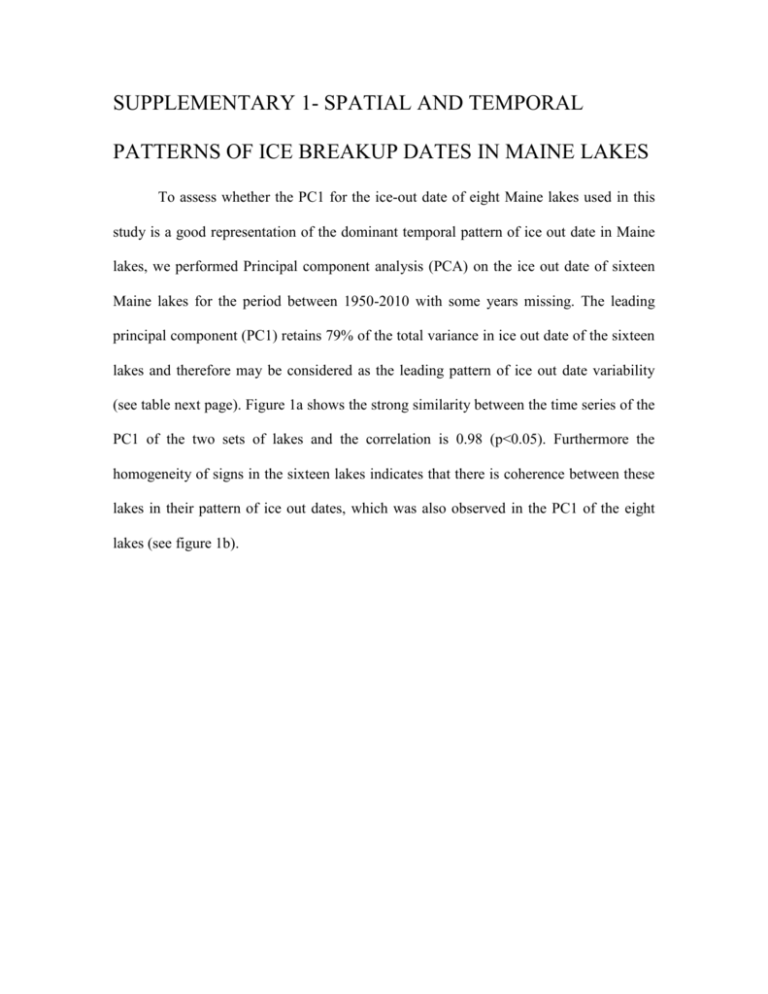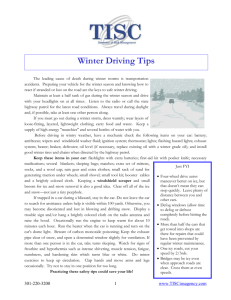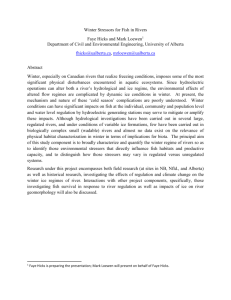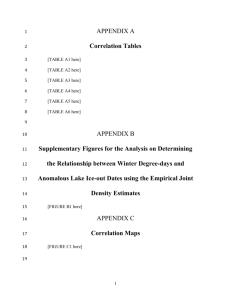lno10148-sup-0002-suppinfo02
advertisement

SUPPLEMENTARY 1- SPATIAL AND TEMPORAL PATTERNS OF ICE BREAKUP DATES IN MAINE LAKES To assess whether the PC1 for the ice-out date of eight Maine lakes used in this study is a good representation of the dominant temporal pattern of ice out date in Maine lakes, we performed Principal component analysis (PCA) on the ice out date of sixteen Maine lakes for the period between 1950-2010 with some years missing. The leading principal component (PC1) retains 79% of the total variance in ice out date of the sixteen lakes and therefore may be considered as the leading pattern of ice out date variability (see table next page). Figure 1a shows the strong similarity between the time series of the PC1 of the two sets of lakes and the correlation is 0.98 (p<0.05). Furthermore the homogeneity of signs in the sixteen lakes indicates that there is coherence between these lakes in their pattern of ice out dates, which was also observed in the PC1 of the eight lakes (see figure 1b). Figure 1. The time series and loadings for the first principal component (PC1) of lake ice out dates in Maine for the period 1950-2010. For comparison the PC1 of ice out date for two sets of lakes is shown: one set containing eight lakes with no missing ice out date and another set having sixteen lakes with six years missing. (a) Time series of PC1 for the first and second sets of lakes. The correlation between the two time series was 0.98 (p<0.05). (b) Lake loading of PC1 for the ice out date of the second set with sixteen lakes. Table 1a. Results of Principal component analysis (PCA) for ice-off dates of sixteen lakes (with missing years) Summary table on the principal components (PC1s) Standard deviation Proportion of Variance Cumulative Proportion PC1 29.087 0.791 0.792 PC2 11.048 0.114 0.905 PC3 4.948 0.023 0.928 PC4 4.144 0.016 0.944 Loadings of Lakes in PC1 and PC2 Lake Mooselucmeguntic Richardson Rangeley Aziscohos Umbagog Moosehead Portage Sebec Kezar West Grand Auburn Swan Maranacook China Cobbosseecontee Damariscotta Loading of PC1 -0.197 -0.197 -0.198 -0.183 -0.181 -0.217 -0.149 -0.208 -0.208 -0.284 -0.287 -0.290 -0.288 -0.314 -0.311 -0.368 Loading of PC2 -0.351 -0.338 -0.329 -0.326 -0.296 -0.267 -0.251 -0.099 -0.046 0.070 0.171 0.176 0.206 0.222 0.227 0.325 PC5 3.611 0.012 0.956 PC6 3.154 0.009 0.966 PC7 2.745 0.007 0.973 PC8 2.595 0.006 0.979 SUPPLEMENTARY 2- INFLUENCE OF NORTHERN HEMISPHERE SEA SURFACE TEMPERATURES ON MAINE’S WINTER TEMPERATURE For the sake of comprehensiveness, the PC1 time series of winter AFDD and AMDD in Maine were correlated with sea surface temperatures and upper air (500mb) geopotential heights to determine other oceanic-atmospheric circulation patterns that influence winter temperature variability and in turn spring ice out date in Maine. The PC1 of winter AFDD and AMDD showed a significant correlation largely with sea surface temperature anomalies along North Atlantic and Pacific and Tropical Atlantic (see figure next page). This result indicates that teleconnection patterns such as Atlantic tripole (ATI), Atlantic multidecadal oscillation (AMO) and Pacific decadal oscillation (PDO) with sensitivity to sea surface anomalies in this region may shape inter-annual variability of winter degree-days and spring ice off dates in Maine (see table next page). However the mechanisms that underlie the mode of these sea surface temperature anomalies (and their teleconnections), their persistence and seasonality are less understood. Thus, we limit our focus to the understanding the season-ahead causal relationships between select teleconnection patterns, suitable degree-day indices in the context of lake ice out. Figure 1. The 1950-2010 composite winter sea surface temperature and 500mb geopotential height anomaly maps correlated against the time series of PC1 for winter AFDD (top) and PC1 for winter AMDD in Maine (bottom). Correlation coefficients exceeding 0.25 are significant at 95% confidence level. 6 Year Year PC1 of Winter AFDD PC1 of Winter AMDD PC1 of Spring AFDD PC1 of Spring AMDD Winter TNH Index Winter NAO Index Winter PNA Index Winter PDO Index Winter AMO index Winter AT index Winter NP index Winter AO index October SAI index Lake Ice out dates 1 -0.15 -0.09 -0.07 0.24 0.14 0.44 0.35 0.4 -0.16 0.21 -0.2 0.3 0.16 -0.26 PC1 of Winter AFDD PC1 of Winter AMDD PC1 of Spring AFDD PC1 of Spring AMDD Winter TNH Index Winter NAO Index Winter PNA Index Winter PDO Index Winter AMO Index Winter AT index Winter NP Index Winter AO index October SAI index Lake ice out dates 1 -0.5 0.2 0.26 0.38 0.06 0.1 0.16 -0.50 -0.41 0.13 0.01 -0.52 0.38 1 -0.14 -0.26 -0.24 0.44 -0.07 -0.06 0.11 0.17 -0.13 -0.31 0.56 -0.51 1 0.61 -0.17 -0.02 0.19 -0.03 0.08 0.01 -0.18 -0.2 -0.38 0.13 1 -0.07 0.19 0.29 0.26 -0.05 -0.01 -0.19 0.06 -0.47 -0.85 1 0.12 -0.11 -0.09 -0.15 -0.14 0.3 0.26 -0.56 -0.27 1 -0.05 -0.09 -0.14 -0.11 0.12 0.82 -0.79 0.21 1 0.74 0.05 0.17 -0.87 -0.21 0.72 0.29 1 0.01 0.12 -0.66 -0.24 0.5 0.24 1 0.85 -0.01 -0.11 -0.07 0.08 1 -0.1 -0.09 -0.27 -0.15 1 0.37 -0.57 0.14 1 -0.8 -0.1 1 -0.43 1 Table 1. Correlation between the first principal component (PC1) of lake ice out dates, winter and spring degree-days and winter teleconnection patterns. Correlation coefficients in bold are significant at p<0.05. 7 SUPPLEMENTARY 3- ANALYZING THE EFFECT OF CHANGING THE TELECONNECTION THRESHOLDS ON THE RESULTS OF THIS STUDY In this paper, analyses and observations on the influence of “strong” or “extreme” teleconnection patterns on lake ice out dates/winter degree-days in Maine is based on the threshold of the selected teleconnection patterns being in the upper and lower quartiles of the historical indices. The selection of this threshold was made based on the limited sample size (n=61) and higher thresholds would limit the number of subsamples that can be re-sampled. In our case, we have a sample size of 15, wherein mean, median, and box-plot statistics can be meaningfully computed and compared. However, to explore if alterations in this threshold would result in a whole sale change in our observations and conclusions about the efficacy of TNH and NAO phases in engendering early spring ice breakup dates in Maine lakes, the significance of the shift in the median ice out date of select eight lakes during different lower/upper percentiles (0.1, 0.15, 0.2, 0.25, 0.3) of TNH/NAO phases were compared with the unconditional median ice out dates for randomly chosen subsamples years in the study period (see figure on next page). It should be noted that the size of the random sub-samples depends on the percentile chosen. For instance, for the upper/lower terciles of TNH/NAO patterns, the subsample size for the random sub-sample is six (0.1x61=6). It can be observed in figure 1 that indeed strongly negative TNH phases during winter induces a shift towards earlier dates in the spring ice out date of lakes for all regions of Maine although the shift in the median ice out dates for one or two lakes is not highly significant (p<0.05) during the different percentiles. It can also be noted that the influence of strongly 8 positive NAO phases during winter in engendering earlier spring lake ice out dates is limited to the coastal regions since in most cases the shift in the median ice out date of northern or southern interior lakes is not significant (p<0.1). The basis for such observations is that the strength of positive NAO phases in producing warmer winter degree-days is weak in the interior regions as observed in the figure in appendix D. 9 Figure 1. Shifts in median ice out dates and its significance for eight selected lakes from 1950-2010 during (a) lower tercile TNH pattern (TNH<-0.9) and upper tercile of NAO (NAO>0.62) phases (b) lower 15th percentile TNH pattern (TNH<-0.75) and upper 15th percentile NAO (NAO>0.4) phases (c) lower 20th percentile TNH phases (TNH<-0.63) and upper 20th percentile NAO (NAO>0.29) phases (d) lower quartile TNH indices (TNH<-0.47) and upper quartile NAO phases (NAO>0.2) (e) lower 30th 10 percentile TNH indices (TNH<-0.34) and upper quartile NAO phases (NAO>0.16). The variability band for the median ice out date of each lake was constructed using the bootstrap method. Solid lines show 10th-90th percentile range while dotted lines indicated confidence interval at 5th-95th percentile range. The filled triangles represent the median ice out date of each lake either during lower and upper tercile TNH and NAO phases.







